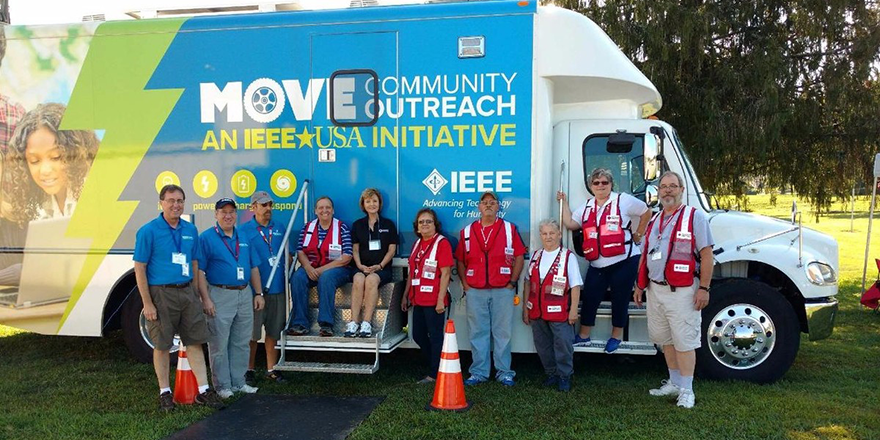They provide the vehicle’s mobile services of emergency power, Internet access, and cellphone chargers to natural disaster victims and aid workers
Since the MOVE Community Outreach project launched in 2016, IEEE volunteers have spent weeks at a time helping out during nine natural disasters in the United States, including in Texas during Hurricane Harvey and in Florida during Hurricane Irma. They provided power in areas of widespread outage, phone coverage via satellite when cellphones and land lines were not available, and disaster relief by helping the displaced access the Internet and reach loved ones.
The MOVE (Mobile Outreach VEhicle) truck is equipped with satellite Internet access, a television connected via a small receiver on the roof for storm tracking, and the ability to charge up to 120 cellphone batteries simultaneously. The truck travels to devastated areas to support emergency relief operations, providing Internet access to relief workers and the public.
MOVE is sponsored by IEEE-USA and receives funding from the IEEE Foundation.
The project has garnered interest from people who have seen it in action. Many of those witnesses have since become IEEE members so that they too can volunteer. Here are three who told The Institute what inspired them to get involved.
MEET THE VOLUNTEERS
While volunteering for the American Red Cross in 2016, Brian Greene’s team was paired with volunteers from the MOVE project to assist victims when Hurricane Matthew reached the Southeastern United States after devastating Haiti. IEEE has a partnership agreement with the American Red Cross. The MOVE volunteers provide technology services; the Red Cross shelters MOVE volunteers during the disaster and assists in determining where the vehicle should be deployed—whether parked near a shelter or used to support relief workers.
Working with MOVE volunteers inspired Greene to join IEEE. He subsequently deployed with MOVE last year during historic flooding in Missouri.
“It is extremely rewarding to help others and give back,” Greene says.
When the MOVE vehicle is not in use, IEEE volunteers take it to schools and science fairs to educate students and community members about ways technology can help people during disasters. Greene says the STEM events are exciting because he gets to teach attendees about relief efforts.
IEEE Member Dusty Fisher has been a STEM advocate for many years. She is past chair of IEEE-USA’s K–12 STEM literacy committee, which aims to improve science, technology, engineering, and math education of preuniversity students in the United States. She also has served on the IEEE Educational Activities Board. When asked to serve as STEM lead for MOVE, she says, she thought it would be a great way to teach students about the intersection of engineering, technology, and humanitarian efforts.
Volunteers give students a tour of the truck, talk about the technology on board, and describe their experiences responding to disasters. They also discuss engineering in general and STEM-related careers.
Fisher was visiting her sister in Houston last year when Hurricane Harvey hit. Her sister’s property was damaged. Fisher says she is thankful for the support from her fellow IEEE volunteers and proud of the work MOVE has accomplished in its two years.
After seeing the devastation caused during last year’s Atlantic Ocean hurricane season, Chris Farrall found out about MOVE through a Google search about ways to become involved and provide relief. He joined IEEE and became MOVE-trained.
Farrall says he believes one of the most important aspects of disaster relief is getting people connected to the Internet and providing cellphone service. He hasn’t been deployed yet but says he plans to volunteer with MOVE on its next mission.
Visit the project’s Foundation Web page to donate to the initiative.


Social Media